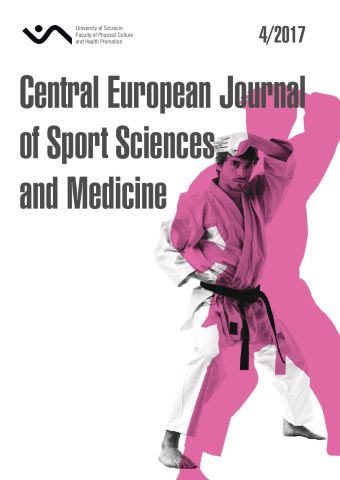
ISSN: 2300-9705
eISSN: 2353-2807
OAI
DOI: 10.18276/cej.2017.4-09




Issue archive /
Vol. 20, No. 4/2017
Occurrence and Intensity of Spinal Pain in Motorcyclists Depending on Motorcycle Type
| Authors: |
Roksana
Wójcik
Department of Physiotherapy, Faculty of Health Sciences, Jagiellonian University Medical College, Cracow, Poland Bartosz Trybulec Department of Physiotherapy, Faculty of Health Sciences, Jagiellonian University Medical College, Cracow, Poland |
| Keywords: | back pain motorcyclists motorcycle type drivers |
| Data publikacji całości: | 2017 |
| Page range: | 11 (81-91) |
Abstract
Introduction: Motorcycles in Poland become more and more popular also as convenient means of transport, especially in large cities. Factors influencing on driver during riding the motorcycle are assumed to cause spinal pain in motorcyclist. These factors may vary in motorcycles of different construction or purpose. Few information is available about spinal pain connected with riding a motorcycle. The aim of this study was the assessment of occurrence and intensity of spinal pain in motorcyclists depending on motorcycle type.
Material and methods: The study group consisted of 2,124 motorcyclists aged 19-79 yrs., using motorcycle with an engine size bigger than 50 ccm and participating in minimum 1 riding season. An original, on-line available questionnaire composed of questions regarding riding a motorcycle and ailments of all parts of the spine was used. The results underwent statistical analysis using the Statistica 10.0.
Results: The results showed that 58.4% respondents experienced pain of at least one part of spine during riding the motorcycle. The biggest percentage (51.1%) of persons with spinal pain in general was found out in cross/enduro type users. Neck pain was significantly connected with riding the sport motorcycle (p=0.001).
Conclusions: Spinal pain in motorcyclists depends on the motorcycle type.
Download file
Article file
Bibliography
| 1. | Akinbo, S.R., Odebiyi, D.O., Osasan, A.A. (2008). Characteristics of back pain among commercial drivers and motorcyclists in Lagos, Nigeria. West African journal of medicine, 2 (27), 87–91. |
| 2. | Balagué, F., Mannion, A. F., Pellisé, F., Cedraschi, C. (2012). Non-specific low back pain. The Lancet, 379 (9814), 482–491. DOI: 10.1016/S0140-6736(11)60610-7. |
| 3. | Balasubramanian, V., Jagannath, M. (2014). Detecting motorcycle rider local physical fatigue and discomfort using surface electromyography and seat interface pressure. Transportation research part F: traffic psychology and behavior, 22, 150–158. DOI: 10.1016/j.trf.2013.12.010. |
| 4. | Bovenzi, M. (2010). A longitudinal study of low back pain and daily vibration exposure in professional drivers. Industrial health, 5 (48), 584–595. |
| 5. | Goode, A.P., Carey, T.S., Jordan, J.M. (2013). Low back pain and lumbar spine osteoarthritis: how are they related? Current rheumatology reports, 15 (2), 305. DOI: 10.1007/s11926-012-0305-z. |
| 6. | GUS (2014). Mały Rocznik Statystyczny. Warszawa. |
| 7. | Hill, J., Lewis, M., Papageorgiou, A.C., Dziedzic, K., Croft, P. (2004). Predicting persistent neck pain: a 1-year follow-up of a population cohort. Spine, 15 (29), 1648–1654. DOI: 10.1097/01.BRS.0000132307.06321.3C. |
| 8. | Hoy, D.G., Protani, M., De, R., Buchbinder, R. (2010). The epidemiology of neck pain. Best Practice & Research Clinical Rheumatology, 6 (24), 783–792. DOI: 10.1016/j.berh.2011.01.019. |
| 9. | Li, Q. (2013). A novel Likert scale based on fuzzy sets theory. Expert Systems with Applications, 5 (40), 1609–1618. |
| 10. | Lis, A.M., Black, K.M., Korn, H., Nordin, M. (2007). Association between sitting and occupational LBP. European Spine Journal, 2 (16), 283–298. DOI: 10.1007/s00586-006-0143-7. |
| 11. | Makhsous, M., Lin, F., Bankard, J., Hendrix, R.W., Hepler, M., Press, J. (2009). Biomechanical effects of sitting with adjustable ischial and lumbar support on occupational low back pain: evaluation of sitting load and back muscle activity. BMC musculoskeletal disorders, 1 (10), 17. DOI: 10.1186/1471-2474-10-17. |
| 12. | Mohd Hafzi, M.I., Rohayu, S., Noor Faradila, P., Wong, S.V. (2009). Prevalence and risk factors of musculoskeletal disorders of motorcyclists. Malaysian Journal of Ergonomics, 1, 1–10. |
| 13. | Sasin, P., Cieślak, W. (2014). Bezpieczeństwo pracy kierowców w transporcie drogowym – ryzyko zawodowe. Przegląd NaukowoMetodyczny „Edukacja dla Bezpieczeństwa”, 1 (7), 111–126. |
| 14. | Sheeran, L., Sparkes, V., Caterson, B., Busse-Morris, M., van Deursen, R. (2012). Spinal position sense and trunk muscle activity during sitting and standing in nonspecific chronic low back pain: classification analysis. Spine, 37 (8), E486–E495. DOI: 10.1097/ BRS.0b013e31823b00ce. |
| 15. | Slatkovska, L., Alibhai, S.M.H., Beyene, J., Cheung, A.M. (2010). Effect of whole-body vibration on BMD: a systematic review and metaanalysis. Osteoporosis international, 12 (21), 1969–1980. DOI: 10.1007/s00198-010-1228-z. |
| 16. | Teoh, E.R., Campbell, M. (2010). Role of motorcycle type in fatal motorcycle crashes. Journal of safety research, 6 (41), 507–512. DOI: 10.1016/j.jsr.2010.10.005. |
| 17. | Williams, V.S., Morlock, R.J., Feltner, D. (2010). Psychometric evaluation of a visual analog scale for the assessment of anxiety. Health and quality of life outcomes, 1 (8), 57. DOI: 10.1186/1477-7525-8-57. |
| 18. | Wągrowska-Koski, E. (ed.) (2007). Zagrożenia zdrowia kierowców pojazdów silnikowych związane ze szkodliwymi i uciążliwymi warunkami środowiska pracy. Instytut Medycyny Pracy im. prof. J. Nofera. |
| 19. | Velagapudi, S.P., Balasubramanian, V., Babu, R., Mangaraju, V. (2010). Muscle fatigue due to motorcycle riding (No. 2010-32-0100). SAE Technical Paper. DOI:10.4271/2010-32-0100. |
| 20. | Villavicencio, A.T., Hernández, T.D., Burneikiene, S., Thramann, J. (2007). Neck pain in multisport athletes. J. Neurosurg: Spine, 7, 408–413. DOI: 10.3171/SPI-07/10/408. |